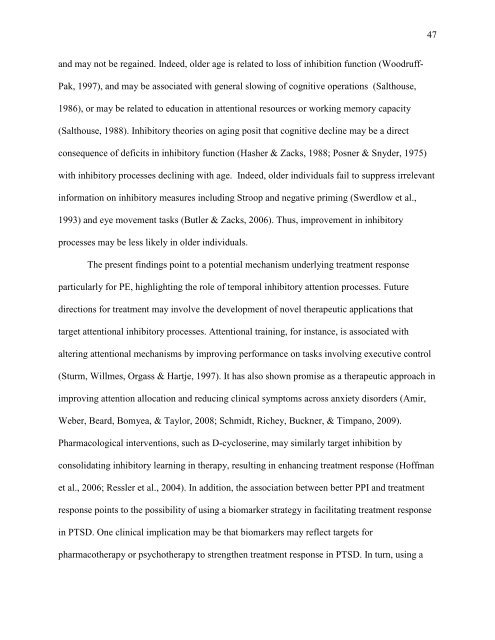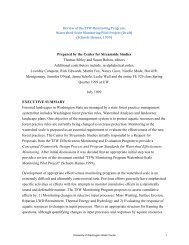Copyright 2012 Aileen M. Echiverri-Cohen - University of Washington
Copyright 2012 Aileen M. Echiverri-Cohen - University of Washington
Copyright 2012 Aileen M. Echiverri-Cohen - University of Washington
Create successful ePaper yourself
Turn your PDF publications into a flip-book with our unique Google optimized e-Paper software.
and may not be regained. Indeed, older age is related to loss <strong>of</strong> inhibition function (Woodruff-<br />
Pak, 1997), and may be associated with general slowing <strong>of</strong> cognitive operations (Salthouse,<br />
1986), or may be related to education in attentional resources or working memory capacity<br />
(Salthouse, 1988). Inhibitory theories on aging posit that cognitive decline may be a direct<br />
consequence <strong>of</strong> deficits in inhibitory function (Hasher & Zacks, 1988; Posner & Snyder, 1975)<br />
with inhibitory processes declining with age. Indeed, older individuals fail to suppress irrelevant<br />
information on inhibitory measures including Stroop and negative priming (Swerdlow et al.,<br />
1993) and eye movement tasks (Butler & Zacks, 2006). Thus, improvement in inhibitory<br />
processes may be less likely in older individuals.<br />
The present findings point to a potential mechanism underlying treatment response<br />
particularly for PE, highlighting the role <strong>of</strong> temporal inhibitory attention processes. Future<br />
directions for treatment may involve the development <strong>of</strong> novel therapeutic applications that<br />
target attentional inhibitory processes. Attentional training, for instance, is associated with<br />
altering attentional mechanisms by improving performance on tasks involving executive control<br />
(Sturm, Willmes, Orgass & Hartje, 1997). It has also shown promise as a therapeutic approach in<br />
improving attention allocation and reducing clinical symptoms across anxiety disorders (Amir,<br />
Weber, Beard, Bomyea, & Taylor, 2008; Schmidt, Richey, Buckner, & Timpano, 2009).<br />
Pharmacological interventions, such as D-cycloserine, may similarly target inhibition by<br />
consolidating inhibitory learning in therapy, resulting in enhancing treatment response (H<strong>of</strong>fman<br />
et al., 2006; Ressler et al., 2004). In addition, the association between better PPI and treatment<br />
response points to the possibility <strong>of</strong> using a biomarker strategy in facilitating treatment response<br />
in PTSD. One clinical implication may be that biomarkers may reflect targets for<br />
pharmacotherapy or psychotherapy to strengthen treatment response in PTSD. In turn, using a<br />
47
















